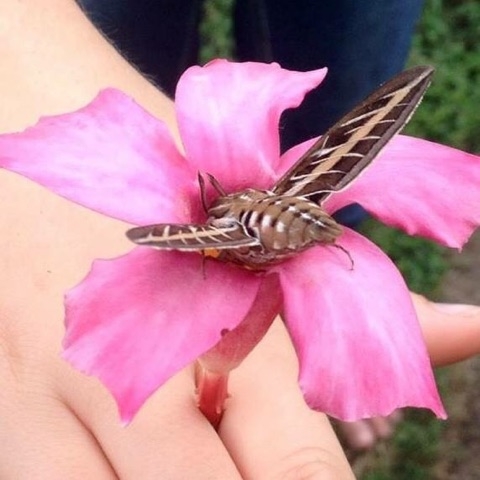National Moth Week begins on July 21st. Yay, a whole week dedicated to studying one of my family’s favorite insects!
Every fall my children stumble upon multiple caterpillars to overwinter, and many of them are moths. The huge Prometheus moth caterpillars are one of our absolute favorites. These chubby little green worms instantly wiggle their way into our hearts. As we scramble to assemble a habitat for our new houseguest, each moth is affectionately dubbed Bob, George, or something else that pops into my kids’ heads. We track down the nearest host plant (which fortunately happens to be our giant oak tree in the back yard!) and fill the enclosure with fresh leaves daily until our caterpillar spins his cocoon. Anxiously, my kids watch and wait until the next spring, when out pops a beautiful moth! We admire his elegance and enormous size (about 5”—he’s a big guy!) before gently releasing him to look for a mate.
While the adult stage of a moth’s life is relatively short, they still play an important part in the pollination of our plants. This is especially true for flowers that open only at night.
Moths are also an integral part of the food chain. They are a significant source of food for both birds and bats. In Africa, moth caterpillars are a major food source for humans, as well. Apparently these little guys are packed with enough protein and healthy fat to be considered a superfood! I’m gonna have to be pretty hungry to jump on that band wagon, though.

There are more than 11,000 species of moth living in the U.S. Talk about diversity! These delicate creatures may at first glance look exactly like a butterfly, but they have a few unique qualities all their own:
- They are mostly nocturnal, flying around at night, where as butterflies are diurnal, and take flight during the daytime. Observe a bright light in the night and you are bound to find moths hovering around. Ever wondered why they seem to gravitate towards your flashlight, campfire, or porch light? Unfortunately, you are going to have to keep on wondering, because scientists still don’t seem to understand or agree.
Some believe moths exhibit a behavior called transverse orientation, which means they navigate by flying at a constant angle to a light source like the moon. When they get near our man-made lights, they become confused because the angle changes as they approach it.
Another theory, put forth in the 1970s by an entomologist named Philip Callahan, proposed that moths are attracted to the light frequencies given off by a candle because they mimicked the frequencies of female moth’s pheromones (which apparently give off a slight luminescence).
Both theories are debated, though.
- Moths are typically smaller than butterflies but can range in size from as tiny as a pencil tip to larger than some songbirds. The largest, the Atlas Moth (which is pictured at the top of the page), is native to Asia and has a wingspan of almost 12″ (30.5 cm).
- The majority of moths are not nearly as colorful as a butterfly. Their camouflage can be so effective that they’re difficult to see when sitting still. The Eudryas grata—ironically known as the “beautiful wood nymph”—is camouflaged to look like none other than bird droppings!
- Moths also have something that most butterflies do not: a frenulum. Humans have an anatomical feature—actually, three of them—with the same name, located in our mouths. The first (and probably best known) in humans is the strong ridge of tissue beneath our tongues, attached to the bottom of our mouths. The others are located at the very front of our mouths, and connect our upper and lower lips to our gums. In moths, the frenulum joins their fore wings to their hind wings. This keeps the two sets in constant contact so they can work together as one surface during flight, making their efforts more efficient.
- One of the easiest ways to tell moths apart from butterflies is their antennae. The majority of moths have feathery antennas. In fact, some species—the Luna moth, for example—can be identified as male or female based solely on the size of their antennae! The male’s are larger and bushier than the female’s.
- A few species of moths (Luna, Prometheus and Atlas, to name a few) don’t even have functioning mouth parts as adults. They emerge simply to reproduce and only live for a few days, perhaps a week at longest, without eating during that time.
- Moths have an incredible sense of smell. A male moth can smell a female more than seven miles away. They just might give a hound dog a run for his money!
I hope you’ll take some time to investigate these fascinating creatures … and perhaps even adopt one temporarily this fall!
You an explore many other aspects of God’s creation
in past posts from our Homeschool category!

Fascinating!